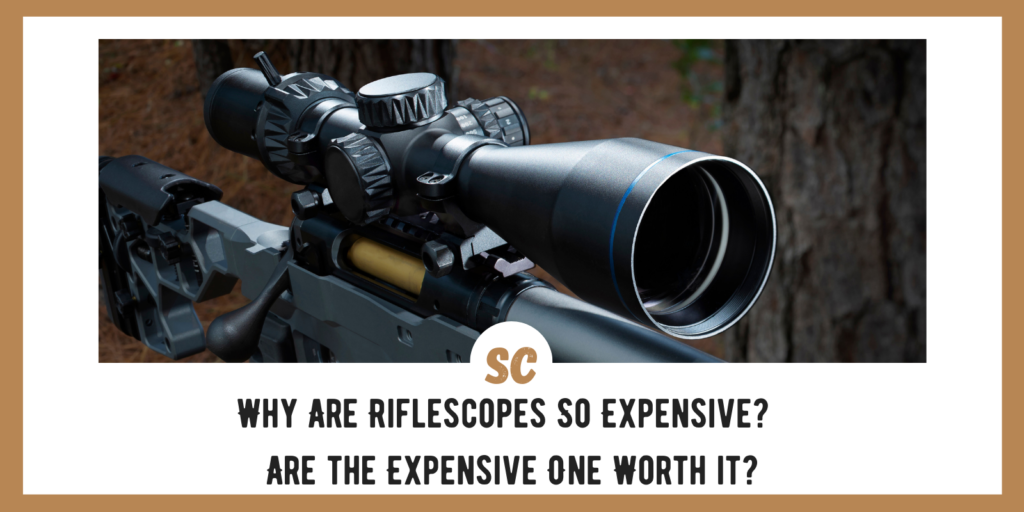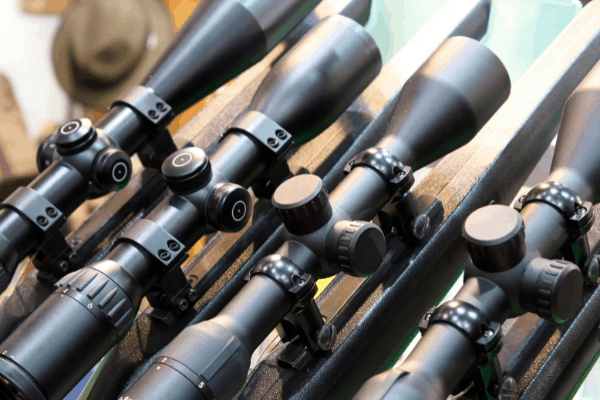Shopping for a riflescope is one of the most confusing and often exasperating parts of assembling a new hunting rifle or target rifle. It seems like every riflescope advertised is the best, has all the features anyone could want, and provides the best clarity and image quality available. Are expensive riflescopes worth the extra money?
In general, the price point of comparable rifle scopes represents the differences in the quality of the optical glass used for the lenses and the tolerances and durability of the internal mechanisms in the scope. Very little of the price difference is represented by the look and finish of the riflescope. It is hard to judge the quality of a riflescope on looks.
Understanding scope manufacturing, how quality affects performance, and what to look for in a quality scope are keys to making a wise scope decision. It is quite easy to spend as much or more on a scope for your rifle as you spend on the rifle itself. Making a wise decision can save you money and help ensure a successful hunt or competition.
SKIP AHEAD
Understanding Your Riflescope – Knowing Where Quality Counts
Despite their relatively simple appearance, modern riflescopes are complex optical tools that require a high degree of precision. It pays to understand these processes and parts to make good judgments about the quality and value of a riflescope. Each riflescope manufacturer has its designs and concepts about riflescope. However, these parts and functions appear on almost all riflescopes.
The Riflescope Tube
The riflescope tube is the main structural component of your riflescope. The tube provides external support for the other parts of the riflescope. Your mounting rings fit around the riflescope tube to attach the riflescope to your rifle.
Most modern riflescopes use aluminum for the tube. Most riflescope tubes are one inch or 30mm in diameter. Since aluminum doesn’t take bluing, most riflescopes feature an anodized finish to protect the scope tube.
Objective Lens and Bell
The front of most modern riflescope has a large bell-shaped housing. This bell-shaped housing encloses and supports the objective lens of the riflescope. The objective lens is responsible for gathering the light transmitted down the scope to the shooter’s eye.
Objective lenses come in a variety of sizes. The most popular size of the objective lens in the United States is 40mm. Larger objective lenses are available and typically found on riflescopes with very high variable magnifications.
The Eyepiece or Ocular Lens
At the other end of the shooter’s scope is the eyepiece holding and protecting the ocular lens. This lens focuses the target image somewhere behind the riflescope within a range called the eye relief. On most modern scopes, the ocular lens is the same diameter as the scope tube.
Turret Knobs
Approximately midway on the riflescope tube is the turrets. These knobs provide the means to adjust the windage and elevation of the scope. You use these turrets to zero the riflescope to provide accurate aiming and shooting.
Turrets come in different styles for different types of shooting. Some scopes have exposed turrets that can be quickly and easily adjusted in the field to change the aiming point. Hunting scopes typically protect the turret adjustments under a cap to increase durability from weather and other damage.
Magnification Ring
Many scopes feature variable magnification powers. These variable magnifications are noted by a hyphenated number such as 4X – 12X, indicating magnification from four times normal to 12 times normal.
The magnification ring is usually located behind the ocular lens or eyepiece for convenience and easy adjustment. Some magnification rings have a short lever to adjust easier and quicker.
Diopter Adjustment
Riflescopes with high magnifications and large objective lenses often include a diopter adjustment on the eyepiece. This adjustment allows you to focus the reticle image to keep it sharp at higher magnifications.
Parallax Adjustment
Extremely high power scopes may offer parallax adjustments on the scope. It may be hard to keep the reticle and the target in the same focus zone at higher magnification. A parallax adjustment allows you to focus the target on the same plane as the reticle.
What You Can’t See, the Internal Mechanisms and Parts
Inside the scope tube is a complex set of mechanisms that allow you to adjust the riflescope. Among these adjustments normally seen on riflescopes are:
- Windage
- Elevation
- Focus
- Parallax
Of these, windage and elevation are perhaps the most important. The windage and elevation adjustments allow you to zero your scope with your rifle for accurate shooting. The windage and elevation turrets connect to a complex mechanism that holds the internal lens and prisms that bend and focus the light collected by the objective lens.
The Erector Mechanism – Keeping it all Inline
Inside the riflescope tube is the erector mechanism. This framework primarily holds the prisms responsible for turning the image in the scope upright so that your eye sees the target image in its proper relationship.
Holding it All Together – The Erector Tube
The erector mechanism rides inside the erector tube. The erector tube suspends inside the riflescope tube by springs and screws connected to the turrets. This suspension system must be robust enough to withstand the shock of your rifle’s recoil yet light and small enough to allow adequate adjustments in the scope without being too heavy to carry.
Your Reticle – First or Second Focal Plane
Many people are confused by the concept of a first or second focal plane reticle. In simple terms, a first focal plane reticle sits at the front of the erector tube. A second focal plane reticle mounts at the rear of the erector tube.
A first focal plane reticle keeps the relative size of the reticle true with the target. The hash marks on the reticle expand or contract as the target magnification increases. Second focal plane reticles remain fixed with the target and don’t expand or contract with the riflescope’s magnification.
Lenses – The Heart of an Optical Riflescope
Everything else about the scope keys toward supporting, protecting, and adjusting the optical lenses in the riflescope. The quality of the optical glass used to make the lenses and the skill of grinding and polishing are the measures of a riflescope.
The finest possible internal and external mechanisms cannot compensate for poor quality optical glass or inaccurate grinding and polishing of the lenses. Likewise, poor quality internal and external mechanisms can negate even the best optics available.
Where Does All the Cost Come In?
Most of the cost of expensive optical scopes is in the optical glass in the lenses. High-quality optical glass is expensive and only comes from a few factories around the world. Cheaper glass is easily available and can produce acceptable results. However, the better the quality of the glass, the higher the cost of the riflescope.
The second most costly part of producing a high-quality riflescope is grinding and polishing the lenses. Grinding and polishing lenses is a technically challenging process and requires precise laboratory conditions to reproduce lenses consistently.
Quality and Durability of the Mechanisms
The best optical glass and lenses in the world aren’t worth more than the internal mechanisms of the scope. Building a quality scope mechanism is always a balancing act between robust design and weight. It is easy to design internal parts for a riflescope that will withstand the recoil of large caliber rifles.
The challenge is designing these mechanisms small enough and light enough to make the riflescope with a range of adjustments to be useful and light enough to be carried on long hunts. The advent of CNC machining has made it easier for manufacturers to produce quality internal parts with accuracy and more economically than ever before.
In general, even the cheapest scope can have perfectly serviceable internal mechanical parts. Most low-end scope manufacturers get their savings by using lower-quality optical glass and opting for faster and cheaper grinding and polishing methods.
So, How Do I Choose the Best Riflescope?
Choosing the right rifle scope for your rifle is part of good shopping techniques and art in many ways. It is hard to judge the internal quality of a sealed and protected riflescope. You can’t see the internal parts that are most critical.
In our experience, the best criterion for selecting a riflescope is the reputation of the manufacturer. Taking the manufacturer’s reputation with the experiences of others gives a good overview of the riflescope.
One thing to avoid is deciding on a riflescope by looking through the scope at the stuffed deer over the cash register at your local sporting goods store. This exercise doesn’t give any idea of how the scope will function in the field or when mounted on your rifle.
Unfortunately, most scope retailers won’t let you take a scope out for a test run on your rifle. At best, you can hope for a generous return policy that allows you to bring the scope back if it doesn’t meet your expectations.
Our Choice of Scope Manufacturers
There are hundreds of scope brands and manufacturers. We have chosen our picks for the most reliable and best value riflescope manufacturers. Other manufacturers produce scopes much higher in price that doesn’t meet the value test for the average shooter or hunter. Likewise, some budget brands of riflescope will give years of good service for some hunters and shooters.
Leupold
Leupold has been building rifle scopes for many years and has earned a reputation for quality and durability. Leupold scopes are the go-to choice for many professional shooters and guides. Leupold rifle scopes can be a bit pricey on some of their upper-tier models, but even these riflescopes deliver excellent value for the price.
Vortex Optics
Vortex Optics is a relatively new competitor in the riflescope market. However, Vortex Optics had garnered a large following among shooters for the quality and clarity of their optics. Backing this reputation is Vortex Optics’ “Ask No Questions” warranty. Of all the scopes on this list, we believe that Vortex Optics offers one of the best price to value ratios you can find.
Athlon Optics
Athlon is probably the least known brand on our list. Athlon produces a full range of styles and types of riflescopes. We have several Athlon riflescopes mounted on both hunting and pong range specialized rifles.
In our opinion, these scopes have amazing clarity even at higher magnifications and deliver rugged, reliable performance. These attributes give these Athlon scopes a great value point for their price.
Bushnell Scopes
There are very few shooters who don’t know the name of Bushnell. Bushnell produces the entire gamut of optical products from riflescopes and binoculars to rangefinders. Bushnell has a history of manufacturing excellent scopes in the mid-range of scope prices. If you are an occasional hunter or target shooter, a Bushnell scope maybe your bests choice to balance performance against price.
In the End, Your Eye will Give you the Answer
Why are good scopes so expensive, and are they worth the extra cost? If you use your scope regularly, you will come to understand the benefits of better and often more expensive riflescopes. You will begin to see the differences in clarity, the crispness of the image, and the light-gathering ability between more expensive scopes and lower-quality glass.




